
Zhao Junsheng's Art Works
Zhao Junsheng is destined to be a painter. He was bornsintosa painter family and his father, Zhao Songtao, was a famed landscape painter in Tianjin. Had suffered and knew well of the hardships of being a good artist, the father didn’t want his children to follow in his footsteps. But against his will, six children out of eight were captivated by muse. Zhao Junsheng didn’t take the advantage to learn the landscapes after his father, instead, he showed great interest in portraits.

Zhao was a very reserved and taciturn boy in his childhood. He got few friends, so the best way to pass the time was to doodle. After he went to primary school, his interest in drawing was still very strong. It was often the case that on class he drew caricatures of his teachers, and imitated the whole picture-story book after class.
Chalks, pencils, pens, all were his tools. Walls, ground, books, were his drawing paper. He wasn’t satisfied with this. He hoped that someday, he would stand in front of the drawing table, just like his father, holding in his hand the brush dipped with Chinese ink, and drew at his will on the soft Xuan paper (a typical kind of paper for Chinese painting). After his constant pleading, his father gave up his original intention and taught him step by step the techniques of traditional Chinese paintings as to how to exert the brush and ink.
From studying after his father to receiving systematic and specialized training in academe of fine arts, Zhao Junsheng has not only mastered the realistic techniques of the Western painting but developed a sensitivity to the delicacy of the traditional Chinese painting as well. Working in the China Art Gallery has made him accessible to the famous paintings of ancient and modern times, China and foreign countries. It is a good opportunity for him to perceive and taste both the advantages and disadvantages of all these paintings, so that he has got parameters according to which he could abandon the weak points and take advantage of the merits in practice.
Now, he is in his fifties, but Zhao’s heart still keeps young. In his mind, doodling is still the most interesting play. Day by day, year after year, he has indulged in his world of painting. Painting always serves as his best treat but not something for pursuing fame or money. He puts all his energy and witsintosit and has therefore given up many pleasures of life.
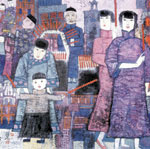  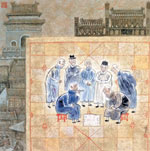
The reason that he hasn’t been bored of painting lies on the fact that he is not a convention-stickler. He is in the process of constant changes and innovations, so that his ardor persists on. He is an eager experimentalist. Serious, humorous, traditional, modern, mainstream, or leisurely styles, all have been tried on.
Being the director of the China Art Gallery, Zhao Junsheng knows clearly that an artist should keep his style as consistent as possible so as to leave deep impression on the market. But in his practice, insgroupsto satisfy his irresistible innovative desires, he has unceasingly denied and abandoned himself.Cotton-padded clothes in winter and silk ones in summer, we change our clothing according to the change of seasons. Ink here and colour there, different painting language presents different feelings. He has tried all techniques, classical, modern, exaggerated, xieyi(freehand strokes),concrete, abstract, and inoculated new ideassintospractice. He painted on his own way just to fully enjoy himself.
Some have said he is avant-garde, some have said he is conservative. Zhao has paid little attention as to what kind of label he has been attached to, neither does he wish that some school would accept him. Since he just takes painting as a way to please his mind, what he takes heavily is the process of creating, but not the painting effect. Neither does he want to set the world on fire, nor does he want to be fettered by fame or fortune. He just wants to give full play to his skills, to handle the ink of thick and light, the colour of cool and warm at will, so that his happiness, anger, sadness and pleasure could be demonstrated thoroughly on the paper.
As he has once said,‘every time the new inspirations came, I would like to put them down with brush without hesitation. Spreading out a piece of Xuan paper parallels facing a dream lover. As soon as getting a chance to speak your mind, you just want to release your feelings without reservation in no time for fear that she might turn away. Even if my words haven’t not carefully chosen, or she might not like my presentation at all, what matters is I have spoken my mind and I enjoyed such experience.
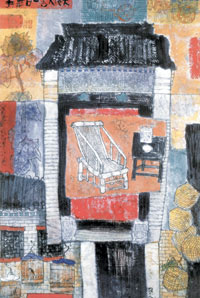
Zhao Junsheng is a sensitive person. He always adopts an amicable and appreciative attitude towards the life and the world around. The subjects of his paintings cover a large scope from literati, celebrities and beautiful ladies to the grass roots. His aim is not to picture the exact figures, but to grasp and reflect their spirits by few, simple, expressive or even exaggerated strokes.
In recent years, he has produced series of paintings of his unique style with themes of‘Poetic People in the Tang Dynasty’and‘Everyday life in the Ancient Capital’. By‘Poetic People in the Tang Dynasty’, he hasn’t intended to represent poems through paintings but to create an agreeable poetic artistic conception. Similarly, paintings of‘Everyday life in the Ancient Capital’aren’t meant to depict the secular world, but to demonstrate the pleasure and wisdom of life. The subjects of the two series are people, yet they have got distinct forms and artistic conception.
The essence of Zhao Junsheng’s‘Poetic People in the Tang Dynasty’are rendered mainly by simple strokes and ink: some are outlined by strokes, some are depicted by carefully controlled ink tone. Thick or thin, dense or light, the brush strokes are not strictly restricted but are produced at will. As a result, the paintings are vivid and brisk without the suspicion of being frivolous, free with ease yet full of emotions. Looking at the poems and postscripts on the paintings, one could feel Zhao’s easiness and dexterity to express himself.In his paintings, the plump beauties in the Tang dynasty all looked at leisure. They were playing so happily and wholeheartedly that you could not find a tint of worry from them. The fisher and woodman who were leading a hard life were not brow-knitted either. On the contrary, they were also wearing an easy look and were enjoying life with a fish and a bottle of wine. Even the intellectuals were dropping their habitual stance of reserve and refinement, and showing instead a kind of simplicity, as if they were free from worldly worries. The humorous and witty tone is in good harmony with his free style. And the visitors would feel Zhao’s genuineness and geniality through his simple brushwork.
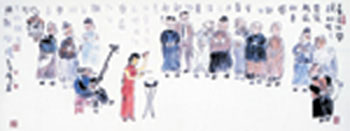
Compared with his predecessor, Chen Shizeng’s‘genre-painting of Beijing’, Zhao has abandoned the misery and melancholy in his paintings, and has only kept the beautiful scenes to form the theme of‘Beauty in ordinary people’s life’. When he drew the storytellers in Tianqiao, he emphasized the fact that Tianqiao gave birth to the art of storytelling and fostered the storytellers. His focus turned to the common people’s tender feeling, when it came to the carrying pole of the hawker and the sugar-coated hawthorn fruits. And the food culture became the theme when the snack stand was involved. Windmills in Changdian and shops selling lanterns and paintings also became part of his works, because he was so surprised by the incessant creativity of the folk art.
As the ancient capital of six dynasties, Beijing has a tradition of both the long history and rich culture. Different regions foster different habitants. Being the people‘under the foot of the emperor’, Beijingers have formed their unique conventions, culture and social historical traditions. Beijingers attached much importance to the etiquette and the proprieties. Venders were always perfectly groomed even they were very poor. Richshaw men were always polite and properly behaved although they were illiterate. Temple fair, market stands in Changdian and Tianqiao, all of these contributed to the bustling, rich and enchanting daily life in Beijing.
Not only the children would be exuberant when rambling in Changdian fair, but even the men in their forties or fifties would comesintoshigh spirits when they shouldered a 11-feet long string of sugar-coated hawthorn fruits. The big wine urns, snack stands and tea houses which could be found all over Beijing attracted people of all trades. In these places, no matter you were noble or humble, poor or rich, intelligent or illiterate, all were equal. People shot the breeze with each other, tasted wine and tea together like old friends, and they could say‘see you tomorrow’when departed.
There are always things that would linger in our memories forever, no matter whether or not they have been sealed by dust of years. Today, with constant changes of modern civilization, our life has become increasingly routine and lack of individuality. Facing the immutable traditions and old scenes and customs, we could not help being moved by their richness and warmth. It is no surprise that when the old Beijingers talk about the past, they could not conceal their yearning and light sadness, which could possibly mingled with some kind of sense of being lost. For them, drinking a bottle of Coca Cola could by no means parallel drinking a bowl of plume juice.
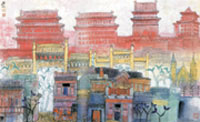 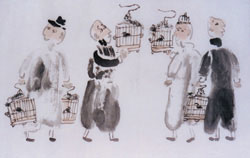
Zhao Junsheng is an artist who takes great interest in both modern and traditional life. He cherishes the folk customs, for in his eyes, they seem to be more humane. He cherishes the ordinary life with national, traditional and regional features. Then he picks up his brush and records them in the form of modern art. He does not intend to show himself off but to express what he thinks and what he feels in this way.
To reproduce the departed life scenes in a vivid and interesting way, mere painting skills are not sufficient, and rich imagination and proper sense of humor should be incorporated. This is just the forte of Zhao who always plays with ink and brushes and paints with ease.
Zhao has reached the state of using the brush at his will. Either paints intentionally or spontaneously, all simple-stroked yet dramatic figures are vivid. The enthusiastic storyteller, the contented string instrument player, the engrossed barber, the man walking birds leisurely, all sorts of people and all life scenes have been fully displayed.
In the center of a painting entitled‘Story teller with drum accompaniment’, there is a graceful young lady storyteller in red gown, with cherry like lip and rosy cheeks. Around her, there are some idle old men with baldheads and are fascinated by her. The contrast between the lady and the listeners is quite funny.
In‘Wrestling’, the static spectators are assembling on one side of the paper, thus, the dynamic main figures are putsintosprominence by large blank space together with their central position. Therefore, the wrestlers’energy is fully released and the whole picture is full of activity and vigour. For the first sight, the structure of the painting is a bit of lopsided, but then you would feel quite comfortable visually.
Flat description should be avoided in genre painting. On this point, Zhao does quite good. He adopts a kind of simple and general brushwork to depict persons. In addition, he pays attention to the environment: He displays the unique atmosphere of the old capital by executing the thick yet somehow blurred colours. He makes the buildings with distinct features serve as the foil for men’s activities. Moreover, he transcends the limit of time and space by not restricting all the subjects in a certain environment.
At first glance, the simple life pleasures contained in these genre paintings coincide with the reminiscent mood of modern people. But if you scrutinized them, you could find more. The caricature like faces and poses of people betray the aging and rigidity of the old time. By this higher cultural connotation, these paintings differentiate and excel from other paintings of the same genre.
It is a bold try to represent the life of old time by modern techniques and conceptions. Yet it is quite successful. The paintings are more expressive, more empathetic, and richer in connotation. This encourages the never satisfactory artist to have another audacious try-abstract ink painting.

In his works, by combining the techniques of traditional Chinese paintings with techniques of Western oil paintings, Zhao Junsheng puts side by side people and the old-fashioned furniture harmoniously. Both people and furniture have got curvy, rich and fluid lines. Yet from the figures, one could feel the corporeal and transitory vitality transmitted. The furniture is lifeless legacy, yet we could still be impressed by their everlasting beauty. By the exaggerated even disproportionate lines, he presented directly before us the reality that has mixed the east and the west, modernity and tradition. And you could be shocked by the cultural clash he has revealed.
Zhao Junsheng is deeply influenced by the expressionism. He hasn’t simply tried to get the effect of expressionist oil paintings, but instead, with originality, he has grafted the ideas and techniques of the expressionism onto the traditional Chinese ink paintings and folk art successfully.
A seal Zhao usually used is engraved with words of‘follow the tradition, while be ready to change.’To some extent, this is also the principle he keeps on his way exploring art. Only when one is ready to change, one could be active, innovative and get breakthroughs. Following the tradition ensures him to retain the characteristics of Chinese ink paintings in the process of his pursuit to innovations and changes. It is just this principle that has guided him to follow the tradition on the one hand yet not to be constrained by it on the other hand. Consequently, he has formed his unique painting style while keeping the traditional features.
Dozens of years have passed since he has committed himself to painting. He has never made advocating speeches or has been engaged in the social activities to advertise himself. He just put the beautiful things onto the paper, and then beauty is there naturally.
|
![]() 本网站由北京信息港提供网络支持
本网站由北京信息港提供网络支持









